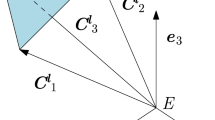Abstract
Models for the gravitational field of Mars moon Phobos were developed using the latest shape model and assuming homogeneous density distribution. Three methods were applied in our study. Comparisons were made between these methods and all were shown to yield consistent results. Notably, the most accurate shape model of Phobos to date, complete up to degree and order 17 was used for the first time in our analysis. A set of spherical harmonic coefficients up to degree and order 17 were derived for the gravitational field of Phobos. Also considered was the gravitational field on the surface of Phobos. Typical characteristics as well as some pronounced surface features of this irregular-shaped small body could be conveniently identified. The results are readily applicable for such purposes as spacecraft orbit analysis and assessing the dynamical environment of Phobos.
Similar content being viewed by others
References
Burns J A. Contradictory clues as to the origin of the Martian moons. Kieffer H H, Jakosky B M, Snyder C W, et al. eds. Mars. Tuscon: University of Arizona Press, 1992. 1283–1301
Craddock R A. Are Phobos and Deimos the result of a giant impact? Icarus, 2011, 211: 1150–1161
Duxbury T C. The figure of Phobos. Icarus, 1989, 78: 169–180
Willner K, Oberst J, Hussmann H, et al. Phobos control point network, rotation, and shape. Earth Planet Sci Lett, 2010, 294: 541–546
Pang K D, Pollack J B, Veverka J, et al. The composition of Phobos —Evidence for carbonaceous chondrite surface from spectral analysis. Science, 1978, 199: 64–66
Thomas P. Surface features of Phobos and Deimos. Icarus, 1979, 40: 223–243
Willner K, Oberst J, Wählisch M, et al. New astrometric observations of Phobos with the SRC on Mars Express. Astron Astrophys, 2008, 488: 361–364
Andert T P, Rosenblatt P, Pätzold M, et al. Precise mass determination and the nature of Phobos. Geophys Res Lett, 2010, 37: L09202
Andert T P, Rosenblatt P, Pätzold M, et al. The internal structure of Phobos and hints to its origin derived from Mars Express Radio Science observations. European Planetary Science Congress, 2011
Davis D R, Housen K R, Greenberg R. The unusual dynamical environment of Phobos and Deimos. Icarus, 1981, 47: 220–233
Thomas P C. Gravity, tides, and topography on small satellites and asteroids — Application to surface features of the Martian satellites. Icarus, 1993, 105: 326–344
Chao B F, Rubincam D P. The gravitational field of Phobos. Geophys Res Lett, 1989, 16: 859–862
Martinec Z, Pec K, Bursa M. The Phobos gravitational field modeled on the basis of its topography. Earth Moon Planets, 1989, 45: 219–235
Balmino G. Gravitational potential harmonics from the shape of an homogeneous body. Celest Mech Dyn Astron, 1994, 60: 331–364
Seidelmann P K, Archinal B A, A’Hearn M F, et al. Report of the IAU/IAG working group on cartographic coordinates and rotational elements: 2006. Celest Mech Dyn Astron, 2006, 98: 155–1
Kaula W. Theory of satellite geodesy: Applications of satellites to geodesy. New York: Dover Publications, 2000. 1–8
Turner R J. A model of Phobos. Icarus, 1978, 33: 116–140
Werner R A, Scheeres D J. Exterior gravitation of a polyhedron derived and compared with harmonic and mascon gravitation representations of asteroid 4769 Castalia. Celest Mech Dyn Astron, 1997, 65: 313–344
Miller J K, Konopliv A S, Antreasian P G, et al. Determination of shape, gravity, and rotational state of asteroid 433 Eros. Icarus, 2002, 155: 3–17
Chao B F, Gross R S. Changes in the earth’s rotation and low-degree gravitational field induced by earthquakes. Geophys J, 1987, 91: 569–596
Garmier R, Barriot J Konopliv, A K, et al. Modeling of the Eros gravity field as an ellipsoidal harmonic expansion from the NEAR Doppler tracking data. Geophys Res Lett, 2002, 29: 1231–1233
Author information
Authors and Affiliations
Corresponding author
Additional information
Recommended by ZHAO Ming (Editorial Board Member)
Rights and permissions
About this article
Cite this article
Shi, X., Willner, K., Oberst, J. et al. Working models for the gravitational field of Phobos. Sci. China Phys. Mech. Astron. 55, 358–364 (2012). https://doi.org/10.1007/s11433-011-4606-4
Received:
Accepted:
Published:
Issue Date:
DOI: https://doi.org/10.1007/s11433-011-4606-4




